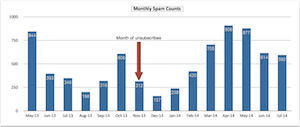Yes, spam is actually still a problem
I hear a lot of people claim that spam isn’t really a problem any more. That filters are so good that the average user doesn’t see a lot of spam and if they do get “legitimate” mail that they can just opt out.
These are great sounding arguments, the problem is that those arguments aren’t always true.
There is an address I stopped using for commercial mail around 1997 and all mail around 2002. It still gets hundreds of emails a month.
Those hundreds of emails a month are despite the fact that the address is behind commercial spam filters. It’s been on “flamers lists.” It’s on the “do not mail” list that came with the “Millions CD.”
In addition, I am very open with clients (and their affiliates) that this is a “spam trap” address. I’ve handed it out to dozens and dozens of companies over the years describing it as my spam trap address.
In November 2013, I unsubscribed from every single email received at that account – at least those that had unsubscribe links.
What does the mail volume look like now?
If anything unsubscribing made the volume problems worse. In the best case it lowered the volume briefly to something approaching 10 emails a day.
There are currently over 500 messages I’ve received so far in August. These are messages advertising companies like Laura Ashley, MetLife, Military.com, Quibids, Walk In Tubs, Sainsbury’s, Bloomburg, Fidelity, Oral B, Lasix Vision Institute, Virgin Broadband, ClickNLoan, Timeshares, iMotors, Walmart, oil changes, Experian, Credit monitoring, Life insurance, ADT, CHW Home Warranty, Health Plans of America, Bosley Hair Solutions, Jillian Michaels Online, restaurant coupons, credit cards, SBA loans, and that’s before we get to the Garcinia cambogia, herbal viagra and clearly fraudulent stuff.
This account, that hasn’t been subscribed to anything in more than 10 years is getting hundreds of unasked for emails a month, even with the benefit of commercial filters. It appears to be being sold or traded in multiple countries (Laura Ashley, Virgin Broadband and Sainsbury’s are all in the UK). I don’t want this mail. I have tried to stop getting this mail.
Yes, spam is still a problem.